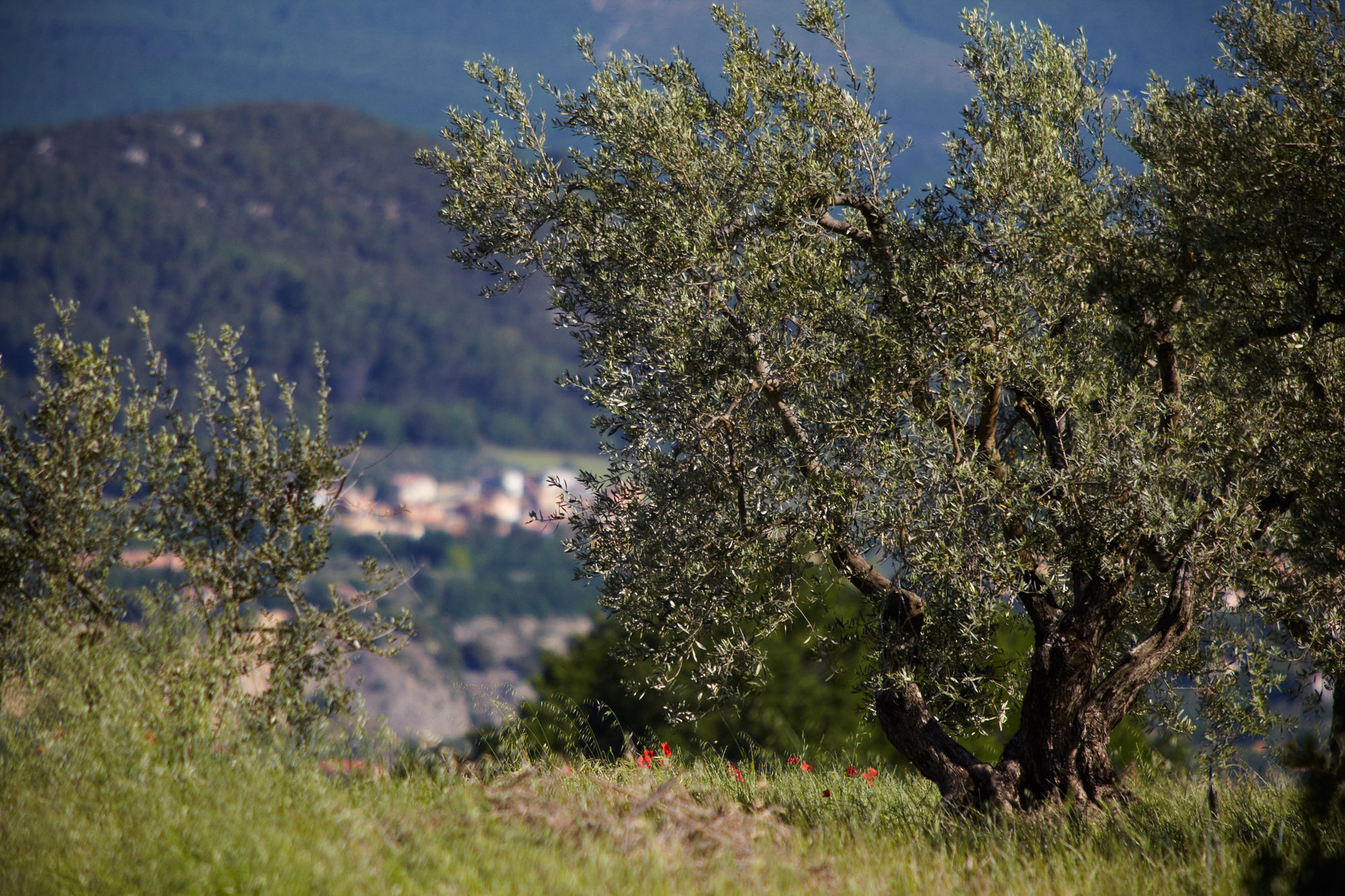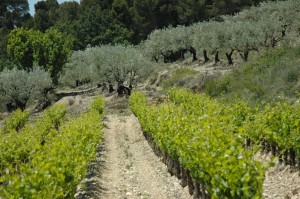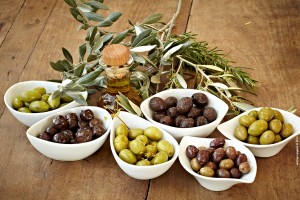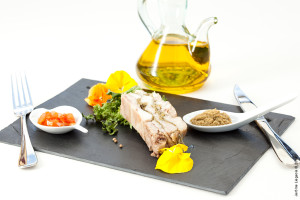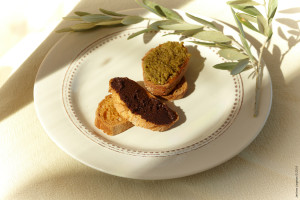Olives : PDO
At the present time, 7 geographical areas have a Protected Designation of Origin (PDO) and 1 is in Appellation d’Origine Contrôlée, the obtaining is on the way, recognized for their olive oil and/or their olives and which identify a historic production core.
- 14 Protected Designation of Origin for olive products are recognized.
- 1 282 over 1 615 olive towns, that is 65% of the olive towns. The size of these areas is very variable: from 16 towns for the Vallée des Baux-de-Provence PDO to 464 towns for the Provence AOC.
- 5 400 acres that is a bit less than 10% of the olive orchard (but ¼ of the olive orchard cultivated by farmers).
- From 600 000 to 700 000 olive trees, that is 17% of the orchard, farmed by around 8 000 olive growers.
- More than 50 transformers.
- 950 to 1 200 tons of olive oil
- 500 to 900 tons of olives
Black olives and olive oil from Nyons PDO
The olive territory of Baronnies is the most northern in France. Its orchard is composed of more than 95% by a single variety:, Tanche, which acclimated perfectly to the climatic conditions, sometimes difficult.
Nyons PDO was obtained in 1994 for black olives and olive oil. Nowadays, the PDO area is made up of 53 towns (35 in Drôme, 18 in Vaucluse), the main are Nyons, Mirabel-aux-Baronnies, Buis-les-Baronnies, La Roche-sur-le-Buis, Venterol, Piegon and Sahune.
PDO since : 1994
Number of olive trees : 261 000
Average annual production of olive oil : 300 tons
Average annual production of table olives : 350 tons
Predominant variety : Tanche.
Its products
- Nyons PDO olive oil : Olive oil from subtle taste characterized by intense freshly cut grass and green apple aromas in the nose and hazelnut aromas with light buttered notes in the mouth.
- Nyons PDO black olive : Harvested in December and January, the Nyons black olive is finely wrinkled by the dryness of the air and first frosts. Only from the Tanche variety, the natural or in brine preparation gives to it a “monk’s robe color” (after contact with air) and a delicious fruity taste recalling undergrowth. “Early” prepared, spotted with fine salt, Nyons olive develops a stronger and more powerful olive taste. It can be used as much for aperitif as for cooking, from starter to dessert.
Olive oil, green broken olives and black olives from the Vallée des Baux-de-Provence PDO
Bouches-du-Rhône is the main olive oil producer in France. The olive tree is present almost on the whole territory with more than 1 180 000 olive trees. This area counts two PDO olive oils: Aix-en-Provence and Vallée des Baux-de-Provence.
In 1997 the Protected Designation of Origin Vallée des Baux-de-Provence was obtained for the black olives, the green broken flavored olives and the olive oil.
PDO since : 1997
Olive tree number : 586 000
Average annual production of olive oil : 450 tons
Average annual production of table olives : 130 tons
Predominant varieties : Salonenque, Aglandau, Grossane, Verdale des Bouches-du-Rhône, Béruguette.
Its products
- Vallée des Baux-de-Provence PDO olive oil : The PDO area offers 2 family tastes:
- Vallée des Baux-de-Provence PDO olive oil with intense taste, lightly peppered, with dominant raw artichoke aromas, with fresh grass, citrus fruits, almond, green apple;
- Vallée des Baux-de-Provence PDO olive oil in characteristic traditional taste with cocoa, truffles and mushrooms aromas.
- Vallée des Baux-de-Provence PDO black olive : Olive from the Grossane variety, harvested in November-December, crystallised with fine salt or naturally prepared in brine. Olives with a “very strong” taste on a bitterness background. This olive ideally accompanies all the dishes.
- Vallée des Baux-de-Provence PDO green broken olives : Olive from Salonenque variety (sometimes Aglandau), harvested in September. Olives are “broken”, that is to say lightly crushed and then put in brine with fennel. The flesh melts in the mouth leaving a slightly acid and plant note. Provence is presented to you!
Aix-en-Provence PDO olive oil
Aix-en-Provence PDO area counts 73 towns (whose 56 in Bouches-du-Rhône) on 2 administrative regions (Bouches-du-Rhône and Var).
Implemented on three sectors, olive plantations are mainly located in l’Arc and La Touloubre valleys and the Trévaresse hillsides. These regions count about 550 000 trees (whose 120 000 are listed as PDO). The analysis of old orchards, the most numerous, indicates that olive plantations of this basin are dominated by three varieties producing very specific oil: Aglandau, Salonenque and Cayanne.
PDO since : 1999
Average annual production of olive oil : 130 tons
Predominant varieties : Aglandau, Cayanne and Salonenque.
Its products
Olive oils produced on the Aix-en-Provence PDO offer two family tastes.
- Aix-en-Provence PDO olive oil – intense taste
It is perfectly suitable for starch, Mediterranean vegetables (tomato, aubergine) and for meats and fishes (such as salmon).
This is an herbaceous olive oil with raw artichoke, apple, greenery and almond aromas often accompanied by bitterness and piquant.
- Aix-en-Provence PDO olive oil – traditional taste or «matured olives»
It harmonizes very well with shellfishes and games as well as with some salads (endives, chicory, escarole,…).
This is a soft and complex olive oil, the nose is dominated by bread and black olive aromas, to which come to be added cooked artichoke, cocoa and vanilla aromas. In the mouth, we can find sourdough bread and black olive, so lingering.
Haute-Provence PDO olive oil
Haute-Provence PDO area stretches on 4 administrative regions (Alpes de Haute-Provence, Bouches-du-Rhône, Var, Vaucluse) and 95 towns (whose 83 in Alpes de Haute-Provence). Towns mainly concerned are located in the “middle Durance Valley” which constitutes the spine of the area, going from Sisteron in the North to Mirabeau in the South.
Haute-Provence PDO olive oil is worked out of 80% minimum of olives from the Aglandau variety..
PDO since : 1999
Predominant varieties : Aglandau (secondary : Bouteillan, Picholine, Tanche and local ancient varieties).
Its products
Haute-Provence PDO olive oil
The aromatic richness of Haute-Provence PDO olive oil allows all culinary agreements. But its intensity will excel in applications on salads with products having a significant taste (arti chokes, sweet peppers), on meats such as lamb, pigeon, game… and starch, mashed potatoes, spelt wheat risotto…
This oil is characterized by a nose of freshly cut grass, raw artichoke or tomato leaf.
In the mouth, raw artichoke flavors dominate, accompanied by the bitterness of almond and harmoniously seasoned with a fruity note of green banana or pear.
Nice PDO olive oil
Nice PDO area radiates on a territory of 99 towns on hillsides and hills from Grasse to Menton, from the sea to the mountains.
The Cailletier variety is also prepared in brine to make the Nice olive, small olive with a characteristic touch of bitterness.
PDO since : 2001
Average annual production of olive oil : 25 tons
Average annual production of olives : 30 tons
Predominant variety : Cailletier.
Its products
- Nice PDO olive oil
Nice PDO olive oil, by its softness, is appreciated by everyone, as much by children as by adults. It generously accompanies salads, vegetables such as potatoes and delicate fishes but can also spice up a strawberry or orange salad.
The characteristic of this olive is its fruity freshness, with very intense fresh almond aromas accompanied by broom and raw artichoke notes.
- Nice PDO olives
Nice PDO olives are naturally prepared (only water and sea salt). This preparation allows removing slowly the bitterness from olives to make them edible while preserving an aromatic high quality. These aromas could remind an old Bordeaux wine, or leather. The flesh remains compact, crunchy and pulls easily away from the stone. The skin of this olive is smooth with shade colors going from yellow to purplish black as well as from brown.
Ideal for aperitifs, the Nice olive suits perfectly to Mediterranean or Nice local dishes. You could also savor it year-round for your pleasure…
Corsica olive oil – Oliu di Corsica – PDO
Corsica PDO area counts 297 towns on 2 administrative regions : Corse du Sud and Haute-Corse.
In Corsica, olive plantations are made up of :
- old orchards with high trees several hundred years old which are harvested by natural fall on nets,
- young plantations, harvested most often by mechanical fall at maturity.
PDO since : 2004
Average annual production of olive oil : 100 tons
Predominant varieties : Sabine (or Aliva bianca), Ghjermana, Capannace (or Raspulata), Avia Nera (or Ghjermana du sud), Zinzala.
Its products
Nice PDO olive oil
Within this large variety and the harvesting methods, Corsica PDO olive oil presents an exceptional aromatic range. This oil is distinct by its softness in the mouth. This is an olive oil with different aromas: fresh grass, cooked vegetables, dried fruits (mainly hazelnut), mint or even myrtle, cistus (maquis smells) and pastries.
Its so characteristic flavor comes from the conjunction of two specific situations in Corsica. On the one hand fruit harvesting in advanced maturity, reducing considerably bitterness and piquant, offers “in fine” a remarkable softness. On the other hand, the aromatic environment of the Corsican maquis is so intense that the fruit becomes impregnate with it.
This is on perfumes and tastes such as straw, artichoke, courgette, myrtle, honey, pastries, apple, walnut, hazelnut or cocoa that we could recognize Corsican olive oil.
Green olives and olive oil Nîmes PDO
Nowadays Gard administrative region counts more than 509 000 olive trees, whose the most famous is the Picholine variety harvested green for confection and ripe for oil.
The Protected Designation of Origin Nîmes was obtained in 2004 for olive oil and in 2006 for green olives. The PDO territory counts 223 towns, mostly located in Gard (some in Hérault).
PDO since : 2004
Number of olive trees : 450 000 (70 000 in PDO)
Average annual production of olive oil : 50 tons
Average annual production of olives : 30 tons
Predominant varieties : Picholine, Négrette, Noirette.
Its products
- Nîmes PDO olive oil : Olive oil in green fruity taste characterised by its intense berries, plums, pineapple (…) aromas with a touch of bitterness and a clear piquant. Olive oil stemming from a minimum of 70% of olives from Picholine variety to which can be added Négrette and Noirette and secondary varieties.
- Nîmes PDO olives : Green olive from Picholine variety, crunchy and juicy, soft with hazelnut butter aromas. Savour mainly for aperitif.
Provence AOC olive oil
Provence AOC area mainly stretches on 4 administrative regions (Var, Vaucluse, Bouches-du-Rhône and Alpes de Haute-Provence) and 464 towns.
Provence AOC olive oil makes a distinction between two specific know-how which exist in Provence : one based on fresh olive’s work and the other on a work of matured olive (stored between harvest and extraction).
AOC since : 2007
Average annual production of olive oil : 200 tons
Predominant varieties : Aglandau, Bouteillan, Cayon, Salonenque.
Its products
The aromatic range of olive oils produced on Provence AOC area is wide and includes different varieties. Two family tastes coexist.
- Provence AOC olive oil, intense taste
It is characterized by a very little intense nose with berries, herbaceous and raw artichokes smells that could be associated to barley water and cinnamon. In the mouth, the fruity taste is intense and characterized by the herbaceous note, raw artichoke, which could be completed by banana, hazelnut, fresh almond and tomato leaf aromas. At the end of the tasting, the pungency could be present, sometimes with notes of bitterness.
- Provence AOC olive oil – «matured olives» or traditional taste
It is characterized by an intense nose and fruity taste, marked by undergrowth, smoke or purple cooked artichoke smells, which could be associated to chocolate or ripe fruits. The mouth is developed and full, with aroma of ripe olive.



